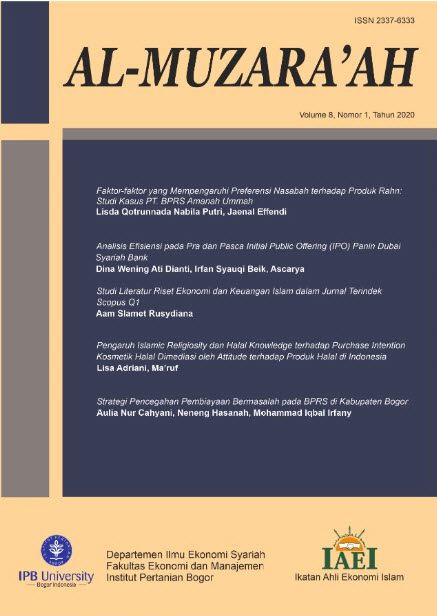Analisis Efisiensi pada Pra dan Pasca Initial Public Offering (IPO) Panin Dubai Syariah Bank
Main Article Content
Abstract
Panin Dubai Syariah Bank (PDSB) conducted an initial public offering (IPO) in January 2014 and was also registered as the first Islamic bank (IB) to conduct an IPO. With an IPO, PDSB is required to provide information disclosure and increase the company's competitive advantage. This study aims to determine 1) financial performance pre and post implementation of the PDSB IPO; 2) the efficiency of the pre and post implementation of the PDSB IPO compared to the IB BUKU 2. The study used a quantitative descriptive approach. The type of data used is secondary data in the form of annual report IB BUKU 2 2010-2017 and IB publication reports. Data were analyzed using the Data Envelopment Analysis (DEA) model to measure efficiency as a concept for evaluating PDSB performance. The results showed (1) CAR pre IPO better than post IPO. BOPO, NPF and FDR there are no significant differences between pre IPO and post IPO (2) PDSB efficiency scores in 2010-2017 are always more efficient when compared to IB BUKU 2. There are significant differences in the parameters of technical efficiency, pure technical efficiency, and scale efficiency on pre-IPO, while post-IPO significant differences only in the efficiency of technical efficiency and scale efficiency.
Downloads
Article Details

This work is licensed under a Creative Commons Attribution-ShareAlike 4.0 International License.
Author(s) who published in this journal agree to following terms:
- Authors understand and agree that copyright of manuscripts published are held by Al-Muzara'ah. The statement to release the copyright to Al-Muzara'ah is stated in form CTA (link doc).
- Copyright encompass exclusive rights to reproduce, to distribute, and to sell any part of the journal articles in all form and media.
This work is licensed under a Creative Commons Attribution-ShareAlike 4.0 International License (CC BY-SA) where Authors and Readers can copy and redistribute the material in any medium or format, as well as remix, transform, and build upon the material for any purpose, but they must give appropriate credit (cite to the article or content), provide a link to the license, and indicate if changes were made. If you remix, transform, or build upon the material, you must distribute your contributions under the same license as the original.
References
Ascarya & Yumanita, D. (2006). Analisis efisiensi perbankan syariah di Indonesia dengan Data Envelopment Analysis. TAZKIA Islamic Finance and Business Review, 1(2), 1-32.
Banker, R.D., Charnes, A. & Cooper, W.W. (1984). Some models for estimating technical and scale inefficiency in Data Envelopment Analysis. Management Science, 30(9), 1078-1092.
Berger, A.N., & Humphrey, D.B. (1997). Efficiency of financial institutions: international survey and directions for future research. European Journal of Operational Research, 98(2), 175-212.
Budiman, R. (2014). Analisis risiko pembiayaan dan determinannya pada perbankan syariah di Indonesia. [tesis]. Bogor, Institut Pertanian Bogor.
Charnes, A., Cooper, W.W. & Rhodes, E. (1978). Measuring efficiency of decision making units. European Journal of Operations Research, 2, 429-444.
Fatmala, E. (2018). Analisis efisiensi perbankan sebelum dan setelah krisis keuangan tahun 2008. [tesis]. Bogor, Institut Pertanian Bogor.
Hadad, M.D., Sugiarto, A., Purwanti, W., Hermanto, M.J., & Arianto, B. (2003). Kajian mengenai struktur kepemilikan bank di Indonesia. Jurnal Buletin Ekonomi dan Moneter Bank Indonesia, Jakarta.
Hendy, M.F. (2008). Go Public: Strategi Pendanaan dan Peningkatan Nilai Perusahaan. Jakarta (ID), PT Alex Media Komputindo.
Karimah, S. (2016). Kajian efisiensi bank umum syariah di Indonesia dan faktor-faktor yang memengaruhinya. [tesis]. Bogor, Institut Pertanian Bogor.
Kuswahariani, W. (2019). Analisis non performing financing pada tiga bank syariah nasional segmen mikro dan secara umum. [tesis]. Bogor, Institut Pertanian Bogor.
Kwan, S.H. (2003). Operating performance of banks among Asian economies: an international and time series comparison. Journal of Banking & Finance, 27(3), 471-489.
Majeed, M.T. & Zanib, A. (2016). Efficiency analysis of Islamic banks in Pakistan. Humanomics, 32(1), 19-32.
Mansyur, F. (2012). Analisis perbandingan efisiensi bank umum syariah dan bank umum konvensional di Indonesia menggunakan metode Stochastic Frontier Approach (SFA). [tesis]. Yogyakarta, UIN Sunan Kalijaga Yogyakarta.
Mezzi, N. (2018). Efficiency of Islamic banks and role of governance: empirical evidence. Managerial Finance, 44(5), 590-603.
Hassan, T., Mohamad, S. & Bader, M.K.I. (2009). Efficiency of conventional versus Islamic banks: evidence from the middle east, International Journal of Islamic and Middel Eastern Finance and Management, 2(1).
Nurwati, E. (2014). Kinerja bank umum syariah, dan keterkaitannya dengan perusahaan induk bank konvensional. [disertasi]. Bogor, Institut Pertanian Bogor.
Puteh, A., Rasyidin, M. & Mawaddah, N. (2017). Islamic banks in Indonesia: Analysis of efficiency. Emerald Reach Proceedings Series, 1, 331–336.
Qureshi, M.A. & Shaikh, M. (2012). Efficiency of Islamic and conventional banks in Pakistan: a non-parametric approach. International Journal of Business and Management, 7(7), 40-50.
Said, A. (2013). Evaluating the overall technical efficiency of Islamic banks operating in the MENA region during the financial crisis. International Journal of Economics and Financial Issues, 3(2), 426–434.
Sharma, D., Sharma, A.K. & Barua, M.K. (2013). Efficiency and productivity of banking sector: a critical analysis of literature and design of conceptual model. Qualitative Research in Financial Markets, 5(2), 195-224.
Wheelock, D.C. & Wilson, P.W. (1999). Technical progress, inefficiency, and productivity change in US banking, 1984-1983. Journal of Money, Credit and Banking, 31(2), 212-34.
Yahya, M.H., Muhammad, J. & Hadi, A.R.A. (2012). A comparative study on the level of efficiency between Islamic and conventional banking systems in Malaysia. International Journal of Islamic and Middle Eastern Finance and Management, 5(1), 48-62.
Yin, H., Yang, J. & Mehran, J. (2015). Do Chinese banks perform better after IPOs? Managerial Finance, 41(4), 368-384.
Zeineb, G.B. & Mensi, S. (2018). Corporate governance, risk and efficiency: Evidence from GCC Islamic banks. Managerial Finance, 44(5), 551-569.

